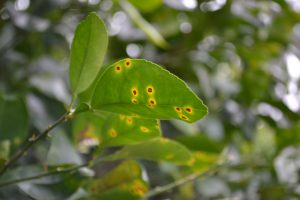Citrus canker has made its way to Escambia County. This bacterial disease was first seen in Northwest Florida almost 10 years ago in Gulf Breeze. Given time and the ease of transmission of this disease, we are now seeing affected citrus trees in both the east and west portions of Escambia County.
This disease is specific to citrus with grapefruit, lemon, and lime being the most susceptible to infection. The disease can infect all above ground tissues and often enters through natural openings and wounds of leaves, stems, and fruit. If you find an infection early in an isolated area of the tree, you can prune out and double bag the affected tissue for disposal. Often times, the disease is noticed only after a considerable amount of tissue and fruit are affected making it difficult to keep the disease in check.
Since the bacteria is so easily transmitted through rain and wind, it is difficult to prevent movement during our frequent storm events. People can also spread the disease by movement of unregulated citrus trees, on equipment, and even on clothing.


If you suspect a citrus in your landscape has canker, do not bring a sample to your Extension office for identification. Take a photo of plant symptoms of upper and lower leaves, fruits, and stems so that your local Extension educators can assist with identification. The University of Florida publication https://edis.ifas.ufl.edu/publication/PP323 has quality photos and descriptions of the different stages of citrus canker, along with photos of other citrus issues.

The bad new for homeowners is that there is not a treatment to cure citrus canker. If the infection is small (a few leaves or a branch), it may be possible to remove and dispose of the material, following proper sanitation guidelines. Homeowners may also suppress a small infection on fruit by using copper-based fungicides, applied at appropriate intervals. These fungicides only protect plant tissue for a short time by acting as a barrier to infection. See this UF publication for timing of copper sprays for fruit.
Once susceptible citrus are heavily infected, trees will have fruit and leaf drop, along with general decline and dieback. At this stage of the disease, homeowners should strongly consider removing the tree. If it can be burned on site in accordance with local burn laws, that keeps the material contained and may reduce disease transmission. Otherwise, all material should be double bagged and sent to a landfill. Do not compost any material onsite or at local composting facilities. Be sure to follow disinfecting techniques outlined in the University of Florida publication https://edis.ifas.ufl.edu/publication/PP323 for tools, hands, and clothing.
Since management of citrus canker is so difficult, prevention is the best method to protect your tree. If you are considering a citrus, choose a more resistant selection outlined in the UF publication, Table 2. Always purchase a citrus from a certified nursery and follow state guidelines which prohibits all propagation of citrus, unless registered to do so.
 0
0
